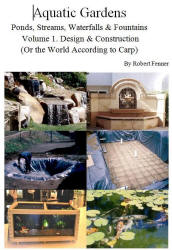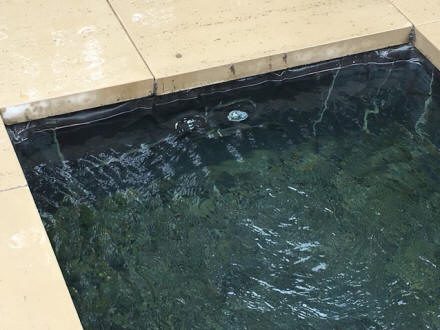|
FAQs on Fiberglass Pond
Repair
Related Articles: Pond
Repair Work, Liners for
Ponds,
Related FAQs: Water Feature Repairs
2, Water Feature Repairs
3, More specifically: Leaks/Leaking, Seepage, Earthen
Pond Repairs, Waterfall Repairs,
Electrical Problems, Fountain Repairs, Faux Rock Repairs, Crack Repairs... & Foundation Coatings, Liner Pond Repairs, Liners in Pond
Construction,
|
|
 |
Aquatic Gardens
Ponds, Streams, Waterfalls
& Fountains:
Volume 1. Design & Construction
Volume 2. Maintenance, Stocking, Examples
V. 1
Print and
eBook on Amazon
V. 2
Print and
eBook on Amazon
by Robert (Bob) Fenner |
 |
|
fiberglass on top of rubber liner for a pond?
7/8/17
Hello and HELP! We recently had a “pond” built in our back yard. I put pond in
quotes because it is more of a reflecting pool than a pond (see photos).
<A very nice job>
It is 2 feet deep, no fish or plants, and has a rubber pond liner with 3 jets
and 4 lights in the pond walls.
<Is it not to be biological? Id est, not have life in it?>
We are not happy with the rubber liner for a few reasons:
While not leaking or causing any problems, the rubber liner has wrinkles along
the walls and in the corners and doesn’t have the sleek contemporary look we
were told by the contractor that it would have once finished
<Mmm; this appearance is really difficult to achieve with liners, particularly
the thicker butyl rubber>
We have black rocks in the bottom of the pond (to help hide the ugly rubber
liner) but cleaning the pond is impossible with the many acorns, heavy
tree/plant pollen, etc. sitting between and underneath the rocks.
<Ah yes... have to drain, remove the rock really to clean. Been there, did this
for several years commercially>
Even when the pond is drained you have to hand pick out the acorns and small
debris from between/under the rocks, which is no small/easy feat.
We’ve been told that fiberglass can be sprayed over the existing liner
to give a smooth surface, but I haven’t found any information about
that process online (much less identified anyone locally that could do it).
<Mmm; I wouldn't do this... the fiberglass will not last, and is toxic in the
short term and a real mess to remove, fix... IF you must have a smooth
surface, DO look into having a "cement plaster coat" (much the same as swimming
pools) applied, likely with some reinforcing mesh (chicken or stucco wire is
what we used to use)... Dark color/oxide can be added to the "plaster", and it
can be smooth troweled... >
We’ve considered just taking the rocks out of the bottom of the pond to make
cleaning easier, but have been told that the rocks might be needed to help weigh
the liner down or it could end up looking even messier/less formed without the
rocks.
Questions:
1. Can you “spray” fiberglass over the existing rubber liner of a pond and, if
so, how likely is it that you will end up with a pond that has smooth surfaces
and not look like a mess?
<There are free-standing (pre-fab) fiberglass ponds, and folks who have done
"chop" and layered fiberglass (and resin) basins, and leak repair tries. Our
company's had a good deal of experience with removing these>
2. Any other ideas on how to manage or change the liner to make it easier to
keep clean and look smooth without completely rebuilding the pond?
<As stated above. See WWM (the Pond SubWeb) and/or my books on water features
(avail. on Amazon) for much more>
3. Any other ideas for what to do about the bottom of the rubber liner other
than rocks to make it easy to keep clean yet look good?
<You may not like this... but adding a dye to the water is about all the
alternative I'd consider>
Thanks! Tony Meyer
<Welcome. Bob Fenner>
|

 |
Fiberglass Koi Pond; repair
7/9/15
Hi experts
I am putting in a fiberglass koi pond and we have a leaking issue at the
rhino drain where it attached to the fiberglass. My installer suggested laying
more fiberglass to build it up.
<Mmm; possibly... is the pond back-filled already? IF it were mine and the
fitting (both sides) was still revealed, I'd undo it (the threaded nut) and add
another gasket, AND Silastic/Silicone rubber, on both sides and retighten w/
just a FEW lb.s of torque>
I need to know if those products for boat repairs etc are harmful to fish.
<Mmm; some are... but so is fiberglass... Many epoxies, when cured, are safe>
Please any ideas? The pond is 1000 gallons and we need to have enough strength
in this to hold the weight of the water from separating from the outside edges
of the drain.
<Yes; understood... and back to my best/original suggestion. Two gaskets and the
Silastic are the optimal choice for leakproofedness, given the eventuality of
change, twisting of the pond, fitting. Have your installer contact me please>
I thank you in advance for your advice
--Robin---
<Welcome. Bob Fenner>
RE: Fiberglass Koi Pond 7/9/15
Hello Bob, Thank you for your fast response - Need a phone number to pass on to
my installer.
<Have them write>
Always in HIS service,
--Robin---
<Whose? Please, no ref.s to invisible friends. BobF>
RE: Fiberglass Koi Pond
Thank you Bob - can you tell me what Silastic is?
<? Use WWM? Your search tool....>
is it a caulk? where does one buy that?
<Deleting the nonsense here. BobF>
fiberglass pond repair 6/11/12
I have a 400gal freeform pond approx.8ft x 6ft 2ft deep with 3 steps [1
at each corner] After 5yrs, it began to loose <lose> water; I removed it
from the garden to look for the leak and found no crack or damage. It
had become porous and water was seeping through all sides. I coated the
areas with resin,
<Should've added a layer of fiberglass cloth>
tested and reinstalled. Now a year later, it is loosing <losing> water
again. The garden is now established and removing it will be a project.
Can the pond be repaired from the inside using fg cloth this time
without causing toxic leaching after curing?
<Yes>
Or should the pond be removed again and reglassed from the outside?
<I'd do from the inside; taking great care to distribute your weight
while in the basin (if you're stepping in)>
Do you have any other suggestions including paints, epoxies, membranes,
rubber coating etc.? I hope this can be a non recurring problem!
<I do. I'd do the repair w/ (hot coat) repair/coating resin (not
casting)
and thin fiberglass cloth (long sleeve shirt, pants, gloves...), please
read here:
http://www.wetwebmedia.com/PondSubWebIndex/FiberglsRepF.htm
Thank you, Doug Long Valley, NJ
<Welcome. Bob Fenner, San Diego, CA>
Re: fiberglass pond repair
Thank you for the quick reply; will have to wait for the frequent
rainstorms to stop then I will prep the pond for repair. Can you
recommend the resin and fiberglass [weight] and where to get the
products [internet].
<Mmm, let's see: are you in the US? If so, it may be necessary for you
to buy in-state... and through a "boat or pool/spa repair" or such
outlet... hopefully they have light weight cloth in rolls. IF you have
not much experience w/ these applications, DO get help from someone who
does>
It looks like the whole interior of the pond will have to be covered. How
long after curing will it be safe for the fish?
<About two weeks for curing (keep the rain and sun out w/ a screen).
BobF>
Thanks again, Doug
using flex seal [tm] for sealing a fiberglass
pond 8/22/11
Hello there....I am in a slight quandary....I am in the process of
installing a 1000 +/- gallon fiberglass shell pond..it had 5, 2 inch
holes cut in it a various places that I fiberglassed over
<Mmm, how? That is, can you describe your repairs? If the areas cut
through could have over-the-hole patches installed on both sides, this
would be ideal. IF not (only the inside being accessible), solid
patches with fiberglass cloth and two coats of hot-coat
resin...>
...found a few cracks in the corners that I also did fiberglass repair
on...think there may be a pin hole or 2 that I may have missed
though....now the big question...do you know if..or would recommend that I
use a rubberized coating on the entire inside of the pond shell ??
<Mmm, I do not. However, my experience w/ such applications has been
dismal. The rubberized coating not really adhering to the fiberglass
over any period of time. Better to use a good grade of suitable
"coating" resin, perhaps colour and material to make it
non-skid (slippery... like sand, walnut shell...)>
..thinking of using
the "as seen on TV" spray on flex seal [tm] stuff...
<This: https://www.getflexseal.com/
and you may want to see here: http://www.scambook.com/group/view/86/Flex-Seal
says on the can and on the website that you can use it on
"ponds"...but in the faq section they do not recommend it for
coating the inside of a drinking water holding tank..
<Different liability...>
I am not sure what to do...replacing the pond shell is not an option as
everything has already been prepped for it's size and shape..approx
10.5 x 5.5/6.5 x 2 ft deep..kinda of peanut shaped..please advise on
this as I have not been able to find any reference to this question
anywhere on the web...thanks for your time, Dave
<Again; I don't have any personal experience w/ this commercial
product; but I would not be using it on a fiberglass pond/surface. Our
bit re fiberglass ponds is archived here:
http://wetwebmedia.com/PondSubWebIndex/fibrglsconstr.htm
and the linked FAQs file above. Bob Fenner>
Re: using flex seal [tm] for sealing a fiberglass pond..part
2 8/22/11
Hello again...forgot the most important info..duh....this pond is
replacing a well established 12 yr old 300 gal plastic
<?... the last email stated the pond/repair involved a fiberglass
shell/basin... of 1000 gallons. Am not following you here. If what
pertinence is this further information? BobF>
pond that is home to several Koi, goldfish, catfish and 2 red ear
sliders..thanks, Dave
Fiberglass pond repair -- 06/07/07 If you
resurface a pond with fiberglass is it safe to put fish in it, or will
the fiberglass kill the fish thank you Frances <Needs to be cured...
but can be done... Not the best material in almost all cases... unless
the original construct was/is fiberglass and resin... Please read here:
http://www.wetwebmedia.com/PondSubWebIndex/Pond%20Sub%20Web.htm Scroll
down to the tray on "Repair". Bob Fenner>
Repairing fiberglass waterfall -
12/04/06 I am trying to repair a prefab fiberglass waterfall. There
are no cracks in it. It has lost its original coloring as it is nearly
6 years old. <Yes...> We have about 7 fish and I don't want
to use anything that will harm them. Do you know if regular colored
grout can be used? <Do know, and no, cannot be used> Thanks for
any info you could send my way. <A repair can be made if the
original fiberglass/resin isn't too badly delaminated, and the area
behind the break is supported well enough (not too flexible)... with
fiberglass cloth (look for in determinate widths), color/ing if
you'd like, laminating/hot-coat resin and hardener, oh and a
"throw-away" small brush to apply it. The falls must be dry,
clean, and I'd roughen up the surface with a low grit sandpaper of
sorts... do wear gloves, long-sleeve shirt and avoid the bits of
fiberglass removed... let cure... Bob Fenner> <<Bob, as I read
this letter, I thought he was simply trying to restore coloration to an
aged fiberglass structure, not repair a structural piece. I was going
to try my hand at a reply, but you beat me to it *grin* My suggestion
was to be to dry the waterfall surface and try a buffing compound such
as 3M Imperial Rubbing Compound to bring back the coloration...
Oftentimes oxidation of this sort is simply buildup on the surface of
the fiberglass and will buff right out.. I can't tell you how many
lake-worn boats I've brought back to a showroom shine with some
buffing compound and some elbow grease. Hope this helps!
-JustinN>> >Yikes... do see this as you state (now)... Will
re-respond... My input remains the same excepting the use of the
fiberglass cloth, tape... roughen up the surface, re-coat with colored
laminating (not casting) resin and moderate/measured amount of MEK
hardener. Thank you Justin. BobF< >>No problem, Bob, its what
I appreciate most about the community here: the group think concept.
Ideas are better thought out when you have more eyes looking at
problems, I only ask for the same if I have any such similar incidents
*grin*, Subsequently, while on the subject of refinishing a fiberglass
structure as such, what is your opinion of one-part epoxy paints, such
as those used for jet skis? These were some of the more readily
accessible, easy to use, and cheap types of paint I dealt with in my
time in the body work industry, and always gave very nice results.
Would you feel them to be adequate for such a situation as described
above? -JustinN<< <Mmm, likely so... given very thorough
prep... Part of the reason I like the "hot coat"
surfboard/use resins... they're much more "sticky",
forgiving. Cheers, BobF> Lining a concrete pond
11/18/06 Hello WWM Crew, <Brian> Warm greetings from Sydney
Australia where we are just entering summer and enjoying the worst
drought in a thousand years (I am not sure how they worked that out as
records only go back about 150 years!). <And such even numbers...
reminds one of "budget" numbers from simple servants in the
U.S.> I am very impressed with your extensive knowledge you share
with the Web community and thank you for that. I have a
problem I was hoping you could assist with. <Will try> I have
converted an old sunken garden into a pond by rendering it and covering
the render with a two-part waterproof paint the name of which escapes
me. It is about 10 feet by 8 feet and about 3 feet
deep. It is a very happy home for seven goldfish and a whole
bunch of vegetation. This worked fine for 8 to 10 years but
has recently developed a leak. I found what I thought was
the leak, scratched it out and filled with a silicon glue (a Selleys
product) which seemed to slow the leak down but didn't stop it. I
suspect there are roots from my neighbor's pine trees involved.
<Very common> I have decided to line the existing concrete pond
with a butyl rubber membrane and although I have scoured your excellent
website I can't seem to find an answer to my questions. Can you
comment on my decision to line the pond? <Is excellent... the roots
will not penetrate this material> How should I attach the liner to
the concrete? <Best to fashion a "lip" of sorts to hand
the membrane in, pinch it to... and cap this with some sort of masonry
with thin set mortar> How should I deal with the flaps produced when
folding into the corners of the pond? <Try to "fold them in,
leaving a bit loose at the top... though all will stretch and largely
lay flat on filling> Thanks in advance, Brian Lee <Welcome my
friend down under. Bob Fenner> Fixing pond
leaks 9/5/06 Hi, I have a small outdoor pond that is
old and cement. It has cracks. What
filler can I use under water and wet that won't kill
the plants or fish? Geralin <... No filler...
need to remove all, repair... Please read here: http://www.wetwebmedia.com/PondSubWebIndex/concrepart.htm and
the linked files above. Bob Fenner>
Pond repair advice. Dear Sir, I have a small glass fiber pond
in my garden, which is let into the garden surface and to disguise the
edges, a cement and natural stone layer of about four inches has been
laid on top of the pond edge. A sealing agent, Uni Bond, was added to
the cement to make it waterproof. The pond edge is lower at one end,
where water flows over a small waterfall into a larger pond below the
waterfall. Unfortunately a leak has developed at the lower end of the
pond and water is getting out between the top edge of the fibre glass
pond and the stone work above it, resulting in a serious loss of water
when the pond filtration system is in use. <Very, very common>
Having looked on your web site and found a reference to
Polyurethane/Bitumen and Chlorinated-Rubber, I am wondering if either
of these materials would be suitable to use to seal the leak. Some
years ago I used a material called Pond Seal, which was of a bit
consistency and could be applied with the use of a brush. A couple of
coats of this would seal any leak. This product no longer seems to be
available in this part of the country. <Any idea of its
composition?... As we will likely agree, you need something with good
bonding action for both types of materials (after cleaned thoroughly
and dried of course), and elasticity and "thickness" to do
the job...> I have used G4 previously, but the water eventually gets
between the glass fibre and the G4 sealer and a leak recommences.
<Yes> Perhaps you would be good enough to advise me of the
correct type of material to use for the repair, the quantity sizes
available and price. Yours faithfully, D S Gurd. BEM. <Yes,
certainly... if this area is not very large I am inclined to suggest a
silicone (100%) sealant much like those used for caulking tubs, windows
(just make sure it is 100%, sans mildewcides...) and for assembling
glass aquaria. These come in a few colors... and I would try to get one
that matches your rock, or failing this, the black variety... in
cartridges will be best, with your fingers, perhaps a putty knife to
work into and about the broken/flexing area. This repair will last a
few years, and is your best bet for choices in repair materials. Bob
Fenner>
 |
Aquatic Gardens
Ponds, Streams, Waterfalls
& Fountains:
Volume 1. Design & Construction
Volume 2. Maintenance, Stocking, Examples
V. 1
Print and
eBook on Amazon
V. 2
Print and
eBook on Amazon
by Robert (Bob) Fenner |
 |

